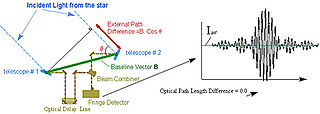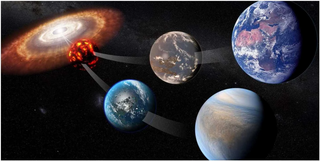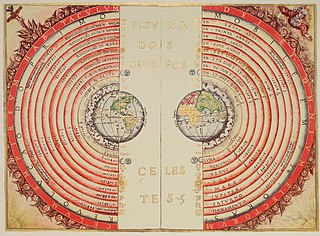
Astrometry is a branch of astronomy that involves precise measurements of the positions and movements of stars and other celestial bodies. It provides the kinematics and physical origin of the Solar System and this galaxy, the Milky Way.

The Drake equation is a probabilistic argument used to estimate the number of active, communicative extraterrestrial civilizations in the Milky Way Galaxy.

Extraterrestrial life, alien life, or colloquially simply aliens is life which does not originate from Earth. No extraterrestrial life has yet been conclusively detected. Such life might range from simple forms such as prokaryotes to intelligent beings, possibly bringing forth civilizations that might be far more advanced than humanity. The Drake equation speculates about the existence of sapient life elsewhere in the universe. The science of extraterrestrial life is known as astrobiology.

Following the discovery of the planet Neptune in 1846, there was considerable speculation that another planet might exist beyond its orbit. The search began in the mid-19th century and continued at the start of the 20th with Percival Lowell's quest for Planet X. Lowell proposed the Planet X hypothesis to explain apparent discrepancies in the orbits of the giant planets, particularly Uranus and Neptune, speculating that the gravity of a large unseen ninth planet could have perturbed Uranus enough to account for the irregularities.

Astronomy is a natural science that studies celestial objects and the phenomena that occur in the cosmos. It uses mathematics, physics, and chemistry in order to explain their origin and their overall evolution. Objects of interest include planets, moons, stars, nebulae, galaxies, meteoroids, asteroids, and comets. Relevant phenomena include supernova explosions, gamma ray bursts, quasars, blazars, pulsars, and cosmic microwave background radiation. More generally, astronomy studies everything that originates beyond Earth's atmosphere. Cosmology is a branch of astronomy that studies the universe as a whole.
The following is a timeline of galaxies, clusters of galaxies, and large-scale structure of the universe.

The Sagittarius Dwarf Spheroidal Galaxy (Sgr dSph), also known as the Sagittarius Dwarf Elliptical Galaxy, is an elliptical loop-shaped satellite galaxy of the Milky Way. It contains four globular clusters in its main body, with the brightest of them—NGC 6715 (M54)—being known well before the discovery of the galaxy itself in 1994. Sgr dSph is roughly 10,000 light-years in diameter, and is currently about 70,000 light-years from Earth, travelling in a polar orbit at a distance of about 50,000 light-years from the core of the Milky Way. In its looping, spiraling path, it has passed through the plane of the Milky Way several times in the past. In 2018 the Gaia project of the European Space Agency showed that Sgr dSph had caused perturbations in a set of stars near the Milky Way's core, causing unexpected rippling movements of the stars triggered when it moved past the Milky Way between 300 and 900 million years ago.

Carl Otto Lampland was an American astronomer. He was involved with both of the Lowell Observatory solar system projects, observations of the planet Mars and the search for Planet X.

In planetary astronomy and astrobiology, the Rare Earth hypothesis argues that the origin of life and the evolution of biological complexity such as sexually reproducing, multicellular organisms on Earth required an improbable combination of astrophysical and geological events and circumstances.
The definition of the term planet has changed several times since the word was coined by the ancient Greeks. Greek astronomers employed the term ἀστέρες πλανῆται, 'wandering stars', for star-like objects which apparently moved over the sky. Over the millennia, the term has included a variety of different celestial bodies, from the Sun and the Moon to satellites and asteroids.

The Milky Way is the galaxy that includes the Solar System, with the name describing the galaxy's appearance from Earth: a hazy band of light seen in the night sky formed from stars that cannot be individually distinguished by the naked eye. The term Milky Way is a translation of the Latin via lactea, from the Greek γαλαξίας κύκλος, meaning "milky circle". From Earth, the Milky Way appears as a band because its disk-shaped structure is viewed from within. Galileo Galilei first resolved the band of light into individual stars with his telescope in 1610. Until the early 1920s, most astronomers thought that the Milky Way contained all the stars in the Universe. Following the 1920 Great Debate between the astronomers Harlow Shapley and Heber Doust Curtis, observations by Edwin Hubble showed that the Milky Way is just one of many galaxies.
Dale A. Frail is a Canadian astronomer working at the National Radio Astronomy Observatory (NRAO) in Socorro, New Mexico.

An Earth analog, also called an Earth analogue, Earth twin, or second Earth, is a planet or moon with environmental conditions similar to those found on Earth. The term Earth-like planet is also used, but this term may refer to any terrestrial planet.

An exoplanet is a planet located outside the Solar System. The first evidence of an exoplanet was noted as early as 1917, but was not recognized as such until 2016; no planet discovery has yet come from that evidence. What turned out to be the first detection of an exoplanet was published among a list of possible candidates in 1988, though not confirmed until 2003. The first confirmed detection came in 1992, with the discovery of terrestrial-mass planets orbiting the pulsar PSR B1257+12. The first confirmation of an exoplanet orbiting a main-sequence star was made in 1995, when a giant planet was found in a four-day orbit around the nearby star 51 Pegasi. Some exoplanets have been imaged directly by telescopes, but the vast majority have been detected through indirect methods, such as the transit method and the radial-velocity method. As of 1 March 2024, there are 5,640 confirmed exoplanets in 4,155 planetary systems, with 895 systems having more than one planet. This is a list of the most notable discoveries.
The Helmi Stream is a stellar stream of the Milky Way galaxy. It started as a dwarf galaxy, now absorbed by the Milky Way as a stream. It was discovered in 1999, is formed of old stars deficient in heavy elements, and has a mass of 10 to 100 million solar masses. It was absorbed by the Milky Way some 6 to 9 billion years ago.

The center of the Universe is a concept that lacks a coherent definition in modern astronomy; according to standard cosmological theories on the shape of the universe, it has no center.

The Laniakea Supercluster is the galaxy supercluster that is home to the Milky Way and approximately 100,000 other nearby galaxies.
Crater 2 is a low-surface-brightness dwarf satellite galaxy of the Milky Way, located approximately 380,000 ly from Earth. Its discovery in 2016 revealed significant gaps in astronomers' understanding of galaxies possessing relatively small half-light diameters and suggested the possibility of many undiscovered dwarf galaxies orbiting the Milky Way. Crater 2 was identified in imaging data from the VST ATLAS survey.












